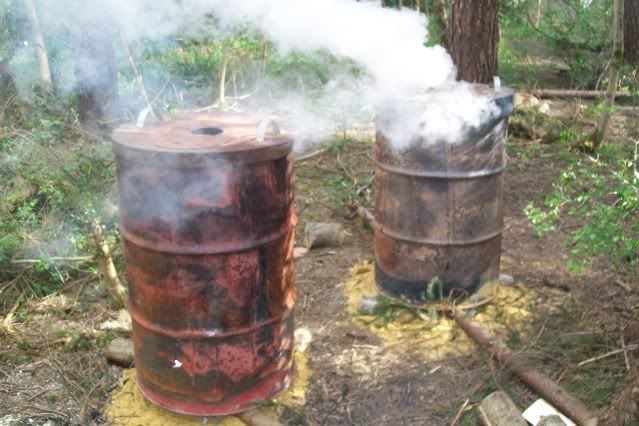I've only just seen this thread, but here's what we did on the course:
As an aside, the course was held in Charnwood Forest which got it's name as it was historically a major producing area for 'Charred Wood' (ie. charcoal).
We used a 45 gallon (210 litre) oil drum which had had the top 1/3 cut off, and had a circular hole cut from the base leaving a lip around 3 inches wide.
We dug a shallow trench (approx. 1 1/2 inch deep) and 1 spade width by approx 2 foot long (so it was around 8 inches wider than the diameter of the drum). Ideally, the trench should be dug in line with the direction the wind is blowing. The drum was then inverted and placed over the trench, with the sides of the drum pushed into the ground to form a seal (with the trench going across the diameter & 4 inches exposed at each side).
Through the hole in the base (now the top) we loaded the wood to be charred, which was coppiced hazel, around 1 1/2 inch in diameter, cut into lengths varying between 6 inches - 1 foot. The first pieces were some of the longer ones which were placed across the trench inside, forming a bridge. The rest of the pieces were then stacked in as tightly as possible until it was around 2/3 full, at which point we continued to stack around the sides leaving a hole in the middle.
We then lit a fire in the middle using old 'bents' (part charred logs from previous burns) and other tinder & kindling. Once the fire was established we stacked more hazel filling the hole and even slightly above the top lip of the drum.
The 'lid' (the full base cut from a separate 45 gallon oil drum - without the rim) was then placed on top and a single log placed on one side (opposite to the side the wind was coming from). The intention being that as the fire burned the logs down, the lid would rest on the top of the drum, except the side held up by the log - thus forming a chimney effect with the trench at the bottom funneling air through the fire.
We then watched the smoke coming from the drum for some time (around 3 hours) until it changed from white/grey to blue/transparent and became much thinner. At this point we removed the log holding the lid up and placed a rock on the lid to hold it down (the heat can make the metal buckle as the drums are relatively thin). We then used the soil dug from the trench to seal the trench on either side of the drum at the base and packed some around the edge of the lid to seal the top. We did have to dampen the soil a little as some was too dry / friable to make a good seal.
We then waited around 2 hours for the kilns to cool before 'testing' them, first by feeling around the sides with our hands for hot spots, then by lifting the lid and listening for crackling (the sound that embers make when they're almost out). Once we were satisfied it was ok, we lifted the drum and then riddled the contents. Any unfinished 'bents' were kept for next time, as were the fines, everything else we bagged and took home - and I had a cracking good barbeque that night.
As previously said, the type of wood, size of wood, whether it is green / seasoned, the size of the kiln, the ambient temperature, amount of wind, and probably numerous other factors will affect the timings. We had two virtually identical kilns, loaded with wood from the same source, located within 10 feet of each other, and they performed differently, one charring quicker, one producing more coals, etc. In my mind its done when its done, and only practice & experience will tell.
A couple of other thoughts:
For those of you using kilns & burning wood beforehand / outside - why? All the wood we used made product.
With respect to how to make charcoal without a kiln, I have previously 'played' at it by building a good fire, putting on some suitable logs, allowing them to catch alight before burying the whole thing in wet sand (not washed sand). This made some nice charcoal, but it was quite an effort afterwards having to dig it all up & sift out the coals, plus the resulting ash/sand mix couldn't be re-used and was only suitable to be added to the compost.
I hope this is of use, sorry for the length of the post, but it was a day long course !!

